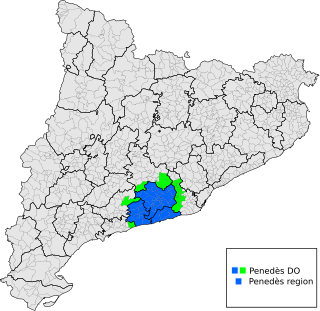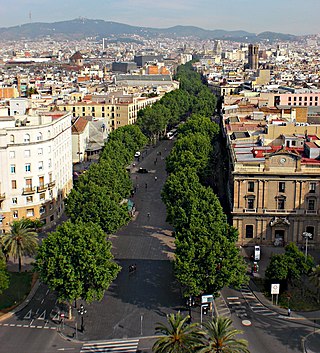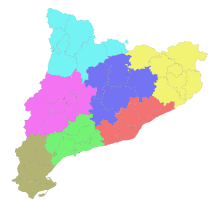
Catalonia is an autonomous community of Spain, designated as a nationality by its Statute of Autonomy. Most of its territory is situated on the northeast of the Iberian Peninsula, to the south of the Pyrenees mountain range. Catalonia is administratively divided into four provinces or eight vegueries (regions), which are in turn divided into 42 comarques. The capital and largest city, Barcelona, is the second-most populous municipality in Spain and the fifth-most populous urban area in the European Union.

The comarques of Catalonia, often referred to in English as counties, are an administrative division of Catalonia. Each comarca comprises a number of municipalities, roughly equivalent to a county in the United States. Currently, Catalonia is divided into 42 comarques and Aran, considered a "unique territorial entity" and not a comarca.

La Seu d'Urgell is a town located in Alt Urgell county in Alt Pirineu, Catalonia, Spain. The town is also the head of its judicial district and the seat of the Bishop of Urgell, one of the co-princes of Andorra. It is located the most populated town of the region, with 17.4% of its population. La Seu d'Urgell and Puigcerdà together have 30% of the population of the area.

Aran is an autonomous administrative entity in northwest Catalonia, Spain, consisting of 620.47 square kilometres (239.56 sq mi) in area, located in the Pyrenees mountains, in the Alt Pirineu i Aran region and in the province of Lleida. The capital is Vielha e Mijaran.

The Province of Lleida is one of the four provinces of Catalonia. It lies in northeastern Spain, in the western part of the autonomous community of Catalonia, and is bordered by the provinces of Girona, Barcelona, Tarragona, Zaragoza and Huesca and the country of France and the principality of Andorra. It is often popularly referred to as Ponent.

Baix Empordà is a comarca (county) in the Girona region, Catalonia, in Spain. It is one of the two comarques into which Empordà was divided in the comarcal division of 1936, the other one being Alt Empordà. It is popularly known as L'Empordanet. The capital is La Bisbal d'Empordà.

Cerdanya is a comarca in northern Catalonia, in the Pyrenees, on the border of Catalonia with France and Andorra. Within Catalonia, Cerdanya is divided between Catalan provinces of Girona and Lleida. Cerdanya's neighbouring comarques are Alt Urgell, Berguedà, and Ripollès.

Camp de Tarragona is a natural and historical region, as well as one of the nine regions (vegueries) of Catalonia. It is the third most populated region, with 536,453 inhabitants as of 2022.

Penedès is a natural and historical region of Catalonia. It is located in the south of the Principality of Catalonia between the pre-coastal mountain range and the Mediterranean Sea. The comarcal division of the Generalitat de Catalunya in 1936 and 1987, divided Penedès into three administrative comarques: Alt Penedès, Baix Penedès and Garraf, and their capitals are Vilafranca del Penedès, el Vendrell and Vilanova i la Geltrú.

Alt Pirineu is one of the nine regions (vegueries) of Catalonia.

Àmbit metropolità de Barcelona, also referred to as the vegueria of Barcelona, is one of the nine regions (vegueries) of Catalonia.

Central Catalonia, also known as Comarques Centrals, is one of the nine regions (vegueries) of Catalonia.

Comarques Gironines or the Girona region is the northeasternmost of the nine regions (vegueries) of Catalonia. It has an area of 5,558 km² and 761,690 inhabitants as of 2022.

Ponent, also known as the Lleida region following the vegueries law, is the westernmost of the eight regions (vegueries) defined by the Regional Plan of Catalonia. It has an area of 5,586 km2, and 365,289 inhabitants as of 2022.

Terres de l'Ebre is the south-westernmost of the eight regions (vegueries) defined by the Regional Plan of Catalonia. It has a population of 182,231 as of 2022, placing it second to last in terms of population. The region includes the comarques of Baix Ebre, Montsià, Terra Alta and Ribera d'Ebre. It is located in the lower course of the Ebre river, and its northern coastal limit is marked by the Coll de Balaguer, a natural limit with the Camp de Tarragona region.

The following outline is provided as an overview of and topical guide to Catalonia:

Alt Pirineu Natural Park is the largest natural park in Catalonia, Spain. The park was established in 2003 by the Generalitat de Catalunya and covers an area of 69,850 hectares, including the highest peaks of the Pyrenees in Catalonia. It stretches over the comarques of Pallars Sobirà and Alt Urgell.

Penedès is one of the eight regions (vegueries) defined by the Regional Plan of Catalonia. Located in south of Catalonia, it includes the comarques from historical Penedès region, along with the southern municipalities of Anoia. It had 497.764 inhabitants as of 2022. It was approved as a region in February 2017.

Alt Ter is a natural region and proposed vegueria by the Ter river in Catalonia.

Catalonia, referring to the autonomous community in Spain, is territorially divided into numerous types and levels of subdivisions with varying administrative, organisational and cultural functions.





















